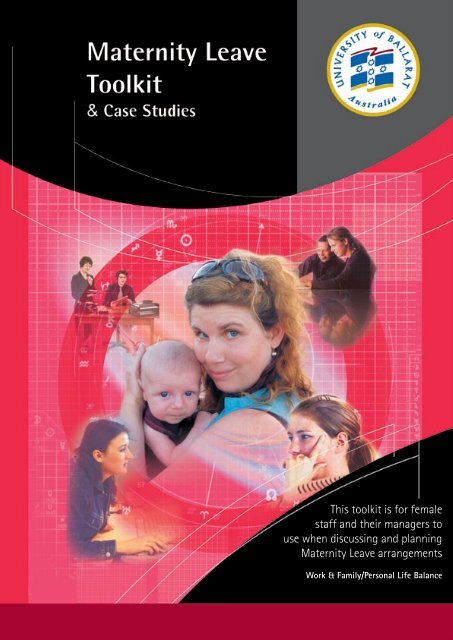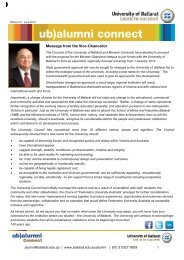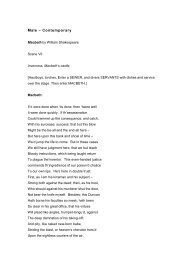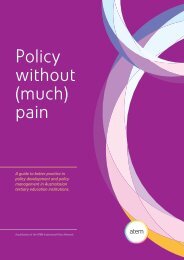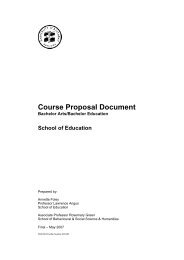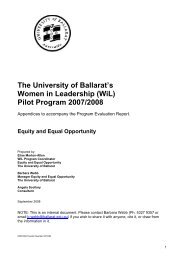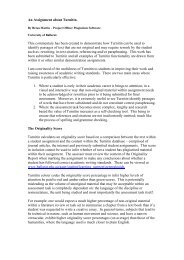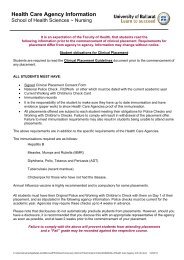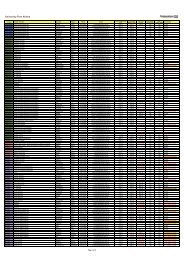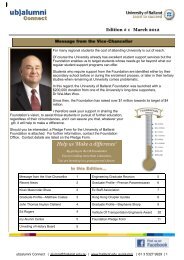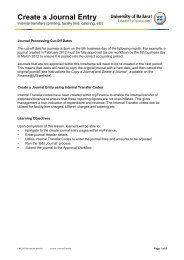Maternity Leave Toolkit - University of Ballarat
Maternity Leave Toolkit - University of Ballarat
Maternity Leave Toolkit - University of Ballarat
- No tags were found...
You also want an ePaper? Increase the reach of your titles
YUMPU automatically turns print PDFs into web optimized ePapers that Google loves.
This toolkit is for female<br />
staff and their managers to<br />
use when discussing and planning<br />
<strong>Maternity</strong> <strong>Leave</strong> arrangements<br />
Work & Family/Personal Life Balance
Maternit y <strong>Leave</strong> <strong>Toolkit</strong> Work & Family /<br />
Personal Life<br />
Balance<br />
Contents<br />
WELCOME!_____________________________________________________________________ 3<br />
A. Initial steps: where do I start_ ______________________________________________ 4<br />
B. Working while pregnant: what are the options________________________________ 5<br />
C. Planning, deciding and formalising <strong>Maternity</strong> <strong>Leave</strong> arrangements______________ 6<br />
D. Keeping in touch with work: getting the balance right__________________________ 8<br />
E. Planning for return to work_________________________________________________ 9<br />
F. Plans and other issues_____________________________________________________ 10<br />
G. She’s back!_ _____________________________________________________________ 11<br />
MATERNITY LEAVE CASE STUDIES______________________________________________ 13<br />
Delia — Planning <strong>Maternity</strong> <strong>Leave</strong>_ ___________________________________________ 14<br />
Marcia — Being flexible_____________________________________________________ 14<br />
Larelle — Managing contract expiry date______________________________________ 15<br />
Adrienne — Lactation facilities_______________________________________________ 15<br />
Leeanne — Manager perspective_____________________________________________ 16<br />
Rose — Win-win solutions_ __________________________________________________ 16<br />
Emma — Flexible solutions before and after_ __________________________________ 17<br />
Lara — Specialised teaching role_ ____________________________________________ 18<br />
Manager scenarios — for managers to trial their response_ ______________________ 19
<strong>Maternity</strong> <strong>Leave</strong> <strong>Toolkit</strong> and Case Studies<br />
This publication has been developed as part <strong>of</strong> a <strong>University</strong> <strong>of</strong> <strong>Ballarat</strong> Work & Family/Personal Life<br />
Balance project managed by Equity and Equal Opportunity, <strong>University</strong> <strong>of</strong> <strong>Ballarat</strong>.<br />
© Copyright 2004 - 2009<br />
The intellectual property within this document remains the property <strong>of</strong> the <strong>University</strong> <strong>of</strong> <strong>Ballarat</strong>,<br />
though the toolkit itself is for use by staff planning for <strong>Maternity</strong> <strong>Leave</strong>.<br />
For more information regarding this booklet<br />
or any other Work & Family/Personal Life Balance issues, please contact:<br />
Barbara Webb<br />
Manager<br />
Equity and Equal Opportunity<br />
<strong>University</strong> <strong>of</strong> <strong>Ballarat</strong><br />
PO Box 663<br />
<strong>Ballarat</strong> Vic 3353<br />
Phone (03) 5327 9357<br />
b.webb@ballarat.edu.au<br />
CRICOS Provider Number: 00103D
Maternit y <strong>Leave</strong> <strong>Toolkit</strong> Work & Family /<br />
Personal Life<br />
Balance<br />
Welcome!<br />
• <strong>Maternity</strong> <strong>Leave</strong> is a process to be worked through jointly by the manager and the staff<br />
member so that good, workable outcomes can be arranged for both parties.<br />
• Pregnancy signals a time <strong>of</strong> great change for both the woman and the work environment.<br />
If it is managed well, staff feel and remain valued members <strong>of</strong> the team.<br />
This toolkit<br />
This toolkit provides a range <strong>of</strong> suggestions, dealing<br />
with:<br />
A. Initial steps: where do I start<br />
B. Working while pregnant: what are the options<br />
C. Planning, deciding and formalising <strong>Maternity</strong> <strong>Leave</strong><br />
arrangements<br />
D. Keeping in touch with work: getting the balance right<br />
E. Planning for return to work<br />
F. Plans and other issues<br />
G. She’s Back!<br />
Working through these sections <strong>of</strong> the toolkit can<br />
provide a step-by-step guide to plan, decide and<br />
formalise <strong>Maternity</strong> <strong>Leave</strong> for both managers and staff.<br />
Suggestion for use <strong>of</strong> this toolkit<br />
Managers and staff could each print a copy <strong>of</strong> this toolkit, or relevant pages, from the Work & Family/Personal Life Balance<br />
website and use it together as a series <strong>of</strong> guided conversations when planning <strong>Maternity</strong> <strong>Leave</strong>. Managers could then<br />
keep it in staff files as a record <strong>of</strong> negotiations with particular staff members. A copy could be given to the staff member<br />
each time you meet so that you are both clear about your previous discussions.<br />
Page 3
Maternit y <strong>Leave</strong> <strong>Toolkit</strong> Work & Family /<br />
Personal Life<br />
Balance<br />
A. Initial steps: where do I start<br />
There are a number <strong>of</strong> resources in the <strong>University</strong> where both staff and managers can<br />
get information and help, especially for the initial steps in planning <strong>Maternity</strong> <strong>Leave</strong>.<br />
1. Visit the Work & Family/Personal Life Balance website at<br />
www.ballarat.edu.au/staff/working-at-ub/human-resources/leave-and-work-life-balance for<br />
• information on <strong>Maternity</strong> <strong>Leave</strong><br />
• information on other leave options (such as leave without pay, special family leave,<br />
recreation leave) that the staff member could think about when planning <strong>Maternity</strong> <strong>Leave</strong><br />
• information on when to have a formal discussion regarding <strong>Maternity</strong> <strong>Leave</strong>.<br />
2. Contact Human Resources for confidential discussions and/or help in understanding<br />
<strong>Maternity</strong> <strong>Leave</strong> entitlements<br />
For consideration_<br />
Staff Member<br />
1. Speaking to your manager well in advance provides<br />
planning opportunities for both you and your<br />
manager. You do not need to provide all your details<br />
to your manager at this stage; rather seek some<br />
support that will help you to get started with your<br />
leave plans.<br />
2. When planning your <strong>Maternity</strong> <strong>Leave</strong>, remember to<br />
consider what entitlements your partner has in this<br />
situation and how it could all fit together.<br />
3. Do you know where you stand if your contract expires<br />
during your <strong>Maternity</strong> <strong>Leave</strong> Read Larelle’s case study<br />
to see what happened with her contract.<br />
4. You can explore your particular situation and options<br />
confidentially with Human Resources<br />
Manager<br />
1. A staff member may want to discuss with you how<br />
her <strong>Maternity</strong> <strong>Leave</strong> will affect her career and any<br />
job issues that may arise once her child is born.<br />
As her Manager, there may be some assistance<br />
that you can <strong>of</strong>fer. If you would like assistance<br />
to explore staff entitlements or return-to-work<br />
options (such as reduction <strong>of</strong> time fraction)<br />
contact Human Resources.<br />
Are there any other issues that you need to address at this stage<br />
Note here any strategies negotiated at this stage, such as preliminary dates, possible work needs or planning issues. Date<br />
and sign the page if required.<br />
________________________________________________________________________<br />
________________________________________________________________________<br />
________________________________________________________________________<br />
________________________________________________________________________<br />
________________________________________________________________________<br />
Page 4
Maternit y <strong>Leave</strong> <strong>Toolkit</strong> Work & Family /<br />
Personal Life<br />
Balance<br />
B. Working while pregnant: what are the options<br />
In some cases a woman may request more flexibility or different work options while<br />
she is pregnant. The challenge for both staff and managers is to negotiate outcomes<br />
that are flexible and fair to both, and to the work area as well. Remember that these<br />
arrangements are temporary, to meet the needs <strong>of</strong> pregnancy.<br />
For consideration<br />
1. Most women continue their usual work during<br />
pregnancy, but sometimes they need some simple<br />
adjustments whilst they are pregnant. Read Emma’s<br />
case study for a good example <strong>of</strong> this. Both managers<br />
and staff may want to discuss the pros and cons <strong>of</strong><br />
changed work options such as:<br />
• Reduced hours <strong>of</strong> work during pregnancy<br />
• More flexible hours during pregnancy<br />
• Any special health or environmental considerations eg<br />
heavy lifting, use <strong>of</strong> chemicals. Read Lara’s case study<br />
and see what she had to consider.<br />
• By law, UB is required to provide a safe workplace,<br />
and sometimes it is necessary to take extra steps to<br />
protect the health and safety <strong>of</strong> pregnant employees.<br />
• Pregnant staff members may need to take the<br />
initiative in this matter, especially in the early stages<br />
<strong>of</strong> pregnancy if they have not yet notified their<br />
managers.<br />
• Check with Risk, Health and Safety where appropriate.<br />
2. Sick leave can be used during pregnancy, regardless<br />
<strong>of</strong> whether the sickness is related to the pregnancy.<br />
Sick leave can also be used for medical appointments<br />
associated with pregnancy. In some regional areas,<br />
where travel is an issue, this may involve a half-day or<br />
more.<br />
3. Remember, during the last 6 weeks <strong>of</strong> pregnancy,<br />
fitness for work is a consideration. The use <strong>of</strong> sick<br />
leave may or may not be appropriate during this time.<br />
Assistance regarding the use <strong>of</strong> sick leave can be<br />
obtained from Human Resources.<br />
Are there any other issues that you need to address at this stage<br />
Note here any strategies negotiated at this stage, such as possible work needs or planning issues. Date and sign the page if<br />
required.<br />
________________________________________________________________________<br />
________________________________________________________________________<br />
________________________________________________________________________<br />
________________________________________________________________________<br />
________________________________________________________________________<br />
________________________________________________________________________<br />
________________________________________________________________________<br />
________________________________________________________________________<br />
________________________________________________________________________<br />
Page 5
Maternit y <strong>Leave</strong> <strong>Toolkit</strong> Work & Family /<br />
Personal Life<br />
Balance<br />
C. Planning, deciding & formalising <strong>Maternity</strong> <strong>Leave</strong> arrangements<br />
Planning, deciding and formalising when the <strong>Maternity</strong> <strong>Leave</strong> will start and end are<br />
crucial steps for both staff member and manager that can be enhanced with open<br />
communication on both sides. Read Delia’s case study for a useful example <strong>of</strong> planning<br />
in action.<br />
1. Planning<br />
When planning <strong>Maternity</strong> <strong>Leave</strong> consider the following issues.<br />
For consideration<br />
Staff Member<br />
1. Are you confident that you know your entitlements<br />
and what options you have These details can vary<br />
according to your type and length <strong>of</strong> employment.<br />
2. Do you have Annual <strong>Leave</strong> that you can use<br />
3. Will you take any unpaid <strong>Maternity</strong> <strong>Leave</strong><br />
4. Will you take the maximum leave that you can, or are<br />
you planning to come back earlier<br />
5. How will you take your paid leave On full pay On<br />
half pay for a longer time<br />
6. How do you want to use your return-to-work bonus<br />
Manager<br />
1. Note the preliminary dates and arrangements that<br />
you are aware <strong>of</strong>, but remember that they will need<br />
to be confirmed at a later stage.<br />
2. Making early plans about replacement staff will<br />
allow time for an effective handover and ease any<br />
pr<strong>of</strong>essional concerns <strong>of</strong> the staff member about<br />
what will happen with her job whilst she is on<br />
<strong>Maternity</strong> <strong>Leave</strong>. If possible, involve the staff member<br />
in replacement planning.<br />
3. Please note that funding for replacement staff is<br />
centrally available for operating and pr<strong>of</strong>ile staff,<br />
but this is not automatic for commercially funded<br />
positions. For information on funding eligibility<br />
please contact Finance.<br />
7. If your contract is due to expire soon and you want<br />
to explore the implications <strong>of</strong> that, contact Human<br />
Resources.<br />
Larelle’s case study shows how she planned around<br />
contract extensions.<br />
Help!<br />
• For leave and pay options contact Human Resources.<br />
Making a start<br />
Both staff members and managers can note below initial planning discussions and negotiations prior to formalising the<br />
<strong>Maternity</strong> <strong>Leave</strong> arrangements.<br />
________________________________________________________________________<br />
________________________________________________________________________<br />
________________________________________________________________________<br />
________________________________________________________________________<br />
________________________________________________________________________<br />
Page 6
<strong>Maternity</strong> <strong>Leave</strong> <strong>Toolkit</strong><br />
Work & Family/<br />
Personal Life<br />
Balance<br />
2. Making the decisions<br />
Once the decisions are made it is time for the staff member and the<br />
manager to get together to formalise them. Remember that UB has<br />
required notice periods that staff must provide:<br />
• see http://www.ballarat.edu.au/staff/working-at-ub/<br />
human-resources/leave-and-work-life-balance<br />
3. Formalising <strong>Maternity</strong> <strong>Leave</strong> arrangements<br />
Managers and staff members – use this table to record the agreed <strong>Maternity</strong> <strong>Leave</strong> details.<br />
Date to start leave _____________________________________________________________________________<br />
Expected date <strong>of</strong> birth _________________________________________________________________________<br />
Medical certificate provided _____________________________________________________________________<br />
Written notification given _______________________________________________________________________<br />
Return date __________________________________________________________________________________<br />
Type(s) <strong>of</strong> leave to be taken ______________________________________________________________________<br />
Return-to-work bonus plans _____________________________________________________________________<br />
End <strong>of</strong> contract issues __________________________________________________________________________<br />
Replacement staff arrangements _________________________________________________________________<br />
_____________________________________________________________________________________________<br />
_____________________________________________________________________________________________<br />
_____________________________________________________________________________________________<br />
_____________________________________________________________________________________________<br />
_____________________________________________________________________________________________<br />
_____________________________________________________________________________________________<br />
_____________________________________________________________________________________________<br />
_____________________________________________________________________________________________<br />
_____________________________________________________________________________________________<br />
_____________________________________________________________________________________________<br />
_____________________________________________________________________________________________<br />
Changed circumstances<br />
There may be changed circumstances throughout the pregnancy and/or leave that require new arrangements to be made.<br />
Jot down any negotiated changes to arrangements as they occur along the way.<br />
________________________________________________________________________<br />
________________________________________________________________________<br />
________________________________________________________________________<br />
Page 7
Maternit y <strong>Leave</strong> <strong>Toolkit</strong> Work & Family /<br />
Personal Life<br />
Balance<br />
D. Keeping in touch with work: getting the balance right<br />
Consider the advantages, for both staff and the work environment, <strong>of</strong> keeping in touch<br />
during <strong>Maternity</strong> <strong>Leave</strong>. Good keeping in touch strategies can help staff feel as though<br />
they are still considered part <strong>of</strong> the place even though they are on leave. As well, if staff<br />
return to work confident and up-to-date with any changes in<br />
the workplace it is more likely that the return will go smoothly.<br />
The three basic things to think <strong>of</strong> here are:<br />
1. Does the staff member want to be kept in touch<br />
2. What will work best in your work area<br />
3. Can the UB website and GroupWise be accessed from home<br />
For consideration<br />
Staff member<br />
1. What level <strong>of</strong> contact do you wish to maintain while<br />
you are on leave It may be that you prefer occasional<br />
contact, lots <strong>of</strong> contact, no contact.<br />
2. Do you want to keep up-to-date with any major<br />
changes taking place while you are on leave, to assist<br />
with the currency <strong>of</strong> your information when you<br />
return<br />
3. Do you want staff newsletters, information about<br />
social events, or email access from home<br />
4. Do you want to be included in meetings about<br />
important decisions that will affect your working life<br />
5. Do you want to be kept informed about pr<strong>of</strong>essional<br />
development opportunities while on <strong>Maternity</strong><br />
<strong>Leave</strong><br />
6. Would you like to be informed about any re-structure<br />
occurring in your work area<br />
7. Will you visit your workplace, particularly close to the<br />
time <strong>of</strong> your return<br />
Manager<br />
1. Talk to the staff member about what level <strong>of</strong><br />
contact they wish to maintain while they are on<br />
leave.<br />
2. What are the logistics involved with keeping in<br />
touch strategies What will work best in your work<br />
area What can you <strong>of</strong>fer<br />
Are there any other issues that you need to address at this stage<br />
Note here any strategies negotiated at this stage.<br />
Date and sign the page if required.<br />
________________________________________________________________________<br />
________________________________________________________________________<br />
________________________________________________________________________<br />
________________________________________________________________________<br />
________________________________________________________________________<br />
________________________________________________________________________<br />
________________________________________________________________________<br />
age 8<br />
P
<strong>Maternity</strong> <strong>Leave</strong> <strong>Toolkit</strong><br />
E. Planning for return to work<br />
Work & Family/<br />
Personal Life<br />
Balance<br />
Women taking <strong>Maternity</strong> <strong>Leave</strong> initially make decisions about their return to<br />
work arrangements before the baby has arrived. It is possible that, as the time<br />
for return draws near, some conditions need to be re-negotiated, or that the<br />
woman is ready to return earlier (or later) than anticipated. It is also possible<br />
that the woman may need to ease back into her job in the early stages, and<br />
will be looking for some extra support. On the other hand, perhaps she wishes<br />
to extend her period <strong>of</strong> leave.<br />
UB can support staff with family friendly practices such as leave without pay,<br />
reduction <strong>of</strong> time fraction for an agreed period, 48/52, flexible work practices,<br />
home-based work, allowing staff to negotiate lactation breaks, providing a private,<br />
clean room for breastfeeding, if possible with access to a fridge and a sink.<br />
For consideration<br />
To assist with making plans go smoothly, it is useful to<br />
start discussions as early as possible, and keep reviewing<br />
these plans as time progresses. It is a good idea to revisit<br />
the Work & Family/Personal Life Balance website<br />
at this point. http://www.ballarat.edu.au/staff/workingat-ub/human-resources/leave-and-work-life-balance<br />
Staff member<br />
1. There may be situations where you want to return<br />
to work earlier than planned, perhaps because <strong>of</strong><br />
money, a re-structure, or just because you are ready.<br />
2. Make contact with your manager to talk about your<br />
return to work arrangements.<br />
3. What will you do if you are asked to return early for<br />
a particular reason, such as a new initiative or a restructure<br />
What flexibility issues might you need to<br />
discuss<br />
4. Do you want changed work hours or more flexibility<br />
on your return to work What is realistic in your work<br />
area What will work best for you Read Rose’s and<br />
Leeanne’s case studies.<br />
5. Will you be still breastfeeding when you return to<br />
work Will you need flexibility to have lactation<br />
breaks for breastfeeding and/or expressing milk<br />
6. Do you want to apply for a further period <strong>of</strong> leave,<br />
without pay<br />
7. If you want to explore return to work options (such as<br />
extension <strong>of</strong> leave or reduced time fraction) contact<br />
Human Resources.<br />
Manager<br />
1. If your staff member wants to return early, what<br />
are the implications for you How could you work<br />
through these<br />
2. Would you consider asking a staff member to<br />
return from leave early if there was a workload<br />
need What flexibility could you <strong>of</strong>fer to make this<br />
possible Read Marcia’s case study for some ideas.<br />
3. Make contact in advance <strong>of</strong> the staff member’s<br />
proposed date <strong>of</strong> return to work. Ask when<br />
would be a good time to discuss return to work<br />
arrangements.<br />
4. If you would like assistance in accommodating<br />
requests for changed, reduced, or more flexible<br />
work hours for your staff member’s return to work,<br />
contact Human Resources.<br />
Read Leeanne’s case study.<br />
5. Ask your staff member if she needs flexibility<br />
for breastfeeding and/or expressing milk breaks<br />
when she returns to work. Is there a private room<br />
with a lock and access to a fridge somewhere on<br />
the campus What can you make available See<br />
Adrienne’s case study for ideas.<br />
Remember that these are usually temporary arrangements whilst the staff member has a<br />
young baby. The best solutions are those that work for staff, managers and the work areas. Read<br />
Marcia’s, Leeanne’s and Rose’s case studies to understand how negotiations can work both ways.<br />
For more detail on exploring options for reduced or flexible hours, see UB’s Flexible Work Arrangements <strong>Toolkit</strong> and UB’s Job<br />
Split, Job Share, Job Support <strong>Toolkit</strong> at www.ballarat.edu.au/staff/working-at-ub/human-resources/leave-and-work-life-balance<br />
Page 9
Maternit y <strong>Leave</strong> <strong>Toolkit</strong> Work & Family /<br />
Personal Life<br />
Balance<br />
F. Plans and other issues<br />
Use this section to record any other issues that have arisen during your discussions<br />
and negotiations about <strong>Maternity</strong> <strong>Leave</strong>. Each case will be an individual one and may<br />
require different arrangements and /or negotiations.<br />
___________________________________________________<br />
___________________________________________________<br />
___________________________________________________<br />
___________________________________________________<br />
___________________________________________________<br />
___________________________________________________<br />
___________________________________________________<br />
___________________________________________________<br />
___________________________________________________<br />
___________________________________________________<br />
___________________________________________________<br />
___________________________________________________<br />
___________________________________________________<br />
___________________________________________________<br />
___________________________________________________<br />
___________________________________________________<br />
___________________________________________________<br />
___________________________________________________<br />
___________________________________________________<br />
___________________________________________________<br />
___________________________________________________<br />
___________________________________________________<br />
___________________________________________________<br />
___________________________________________________<br />
___________________________________________________<br />
___________________________________________________<br />
Help!<br />
Human Resources can provide advice and assistance to staff and/or to managers where there is need for interpretation <strong>of</strong>,<br />
or lack <strong>of</strong> agreement about, staff access to entitlements under awards, enterprise agreements and policies.<br />
Equity and Equal Opportunity can provide advice and assistance to staff who have concerns about fairly accessing<br />
<strong>Maternity</strong> <strong>Leave</strong> and return to work options, and to managers exploring pros and cons <strong>of</strong> flexibility options.<br />
Page 10
Maternit y <strong>Leave</strong> <strong>Toolkit</strong> Work & Family /<br />
Personal Life<br />
Balance<br />
G. She’s Back!<br />
For consideration<br />
Staff member<br />
1. Returning to work after a break <strong>of</strong> up to<br />
twelve months or more can require some<br />
simple adjustments. You know that your home<br />
environment has changed with the addition <strong>of</strong> a<br />
new family member, and usually there have been<br />
some changes in your work environment as well. It<br />
may be that you are looking to ease back into work<br />
over a period <strong>of</strong> time, building up gradually to your<br />
previous time fraction.<br />
2. You might like to discuss with your manager the<br />
pros and cons <strong>of</strong> various work options such as:<br />
• Reduced or more flexible hours <strong>of</strong> work for a set<br />
period<br />
• Workloads and how they will be allocated<br />
• Which hours/days will be best for part-time staff and<br />
how work activities (such as meetings, PD days) can<br />
be scheduled around them where possible.<br />
Manager<br />
1. Consider what you can do to settle in your staff<br />
member when she returns from <strong>Maternity</strong> <strong>Leave</strong>.<br />
No doubt there will have been changes in the work<br />
environment, sometimes quite significant ones, and<br />
managers need to consider what they can do to ease<br />
the staff member into the fold.<br />
2. A focus on the little things is important, such as<br />
organising her desk with pens etc, organising<br />
GroupWise access if it has lapsed, and arranging for<br />
a staff member to greet the returning staff member<br />
and provide a simple re-orientation, especially if there<br />
have been big or unexpected changes at work. A<br />
“welcome back” morning tea can also provide a good<br />
opportunity for staff to re-acquaint themselves.<br />
3. What issues will you have to face if your staff member<br />
requests reduced or more flexible hours <strong>of</strong> work<br />
Perhaps the replacement staff member was full-time<br />
and you now find yourself with two part-time staff<br />
working the one position.<br />
• How will you organise activities such as staff<br />
meetings and PD to include part-time staff<br />
• Is it possible to arrange these things at a time<br />
that will suit part-time workers For example, is it<br />
feasible to arrange childcare for a staff member<br />
so that she can attend important meetings and<br />
other activities<br />
4. The biggest challenge facing managers when a staff<br />
member requests a reduction in work hours, or more<br />
flexible hours, is ensuring that the agreed workload:<br />
• really matches the agreed time fraction. For<br />
example, how can a part-time workload for an<br />
academic staff member include the elements<br />
<strong>of</strong> a full-time load (teaching, research, student<br />
supervision, administration) Read Lara’s<br />
case study and think about how you would<br />
organise her workload if she were your staff<br />
member. Similar considerations apply to other<br />
employment modes.<br />
• best uses the skills <strong>of</strong> the worker. Read Rose’s case<br />
study and Leeanne’s case study for some ideas<br />
about this.<br />
Note below any issues you will have to address when a staff member returns to work from <strong>Maternity</strong> <strong>Leave</strong>.<br />
________________________________________________________________________<br />
________________________________________________________________________<br />
________________________________________________________________________<br />
________________________________________________________________________<br />
Page 11
Maternit y <strong>Leave</strong> Case Studies<br />
In preparation <strong>of</strong> this toolkit<br />
we are very grateful that the case study participants<br />
were willing to share their stories and to be identified in them.<br />
As a result, these case studies provide strong, best practice examples.
<strong>Maternity</strong> <strong>Leave</strong> <strong>Toolkit</strong><br />
<strong>Maternity</strong> <strong>Leave</strong> Case Studies<br />
Work & Family/<br />
Personal Life<br />
Balance<br />
Delia<br />
Planning <strong>Maternity</strong> <strong>Leave</strong><br />
TAFE Teacher SMB<br />
I will be taking six months <strong>Maternity</strong> <strong>Leave</strong> during 2004. I have been teaching in the TAFE<br />
sector for seven years and am currently on a full-time, 2-year contract. I plan to take six<br />
months <strong>Maternity</strong> <strong>Leave</strong> on half pay.<br />
I am due to start my leave three weeks before the end <strong>of</strong> Semester 1, but have negotiated<br />
a mutually agreeable solution with my manager, Peter, and with my students. The last few<br />
weeks <strong>of</strong> term when I am on leave will be workshop time for my students to complete<br />
assessment tasks. I will collect and assess their work early in Semester 2 after my baby is<br />
born. Peter will organise for the results to be recorded later than usual and my students<br />
understand the reason why. They prefer to have me, rather than an unfamiliar teacher,<br />
assessing their work.<br />
I am scheduled to return to work three weeks before the Christmas break, but have<br />
negotiated with my manager to take a combination <strong>of</strong> working from home and recreation<br />
leave before returning full-time for the start <strong>of</strong> the 2005 teaching year.<br />
I have considered talking to my manager about working from home for half a day per week<br />
during 2005 while my baby is little, but I’ll negotiate this with Peter if the time and the need<br />
arise.<br />
Marcia<br />
Being flexible<br />
Administrative Assistant<br />
TAFE School<br />
I had a full-time HEW position before I took my <strong>Maternity</strong> <strong>Leave</strong>. My manager, Virginia,<br />
asked me to return earlier than my scheduled date because she was establishing a new role<br />
and didn’t have an admin assistant. Virginia was prepared to accept whatever hours I could<br />
manage, so I started with half a day and progressively moved up to full-time once more. In<br />
the early stages <strong>of</strong> my return Virginia was able to access back up support from within the<br />
<strong>of</strong>fice. This meant I could find my feet and work out a routine for my family bit by bit.<br />
I was still having some medical treatment when I returned but was given the flexibility to<br />
take appointments when I could get them. A re-structure in the school meant that I had a<br />
new manager, Peter, but he was great to work with as well.<br />
I still have the flexibility to leave 10 minutes early to collect my daughter from childcare. To<br />
compensate, I start 10 minutes early in the mornings.<br />
It’s all about flexibility and being able to negotiate what works well for you and your<br />
manager. The flexibility I had from both my managers made the transition back into work<br />
easy for me. It was great.<br />
Page 14<br />
www.ballarat.edu.au/aasp/staff/workfamily/
Maternit y <strong>Leave</strong> <strong>Toolkit</strong><br />
Work & Family /<br />
Personal Life<br />
Balance<br />
<strong>Maternity</strong> <strong>Leave</strong> Case Studies<br />
Larelle<br />
Managing contract expiry date<br />
Administrative Assistant<br />
TAFE<br />
First time<br />
When I planned my first lot <strong>of</strong> <strong>Maternity</strong> <strong>Leave</strong> there was no information available on the<br />
Human Resources’ web page. It’s good to see some information there now.<br />
I had been working at UB in a full-time contract position for nearly three years when I<br />
became pregnant. I wanted to take 12 months <strong>Maternity</strong> <strong>Leave</strong> but my contract was due to<br />
expire during this time. I knew that I could only apply for <strong>Maternity</strong> <strong>Leave</strong> that fell within the<br />
time frame <strong>of</strong> my current contract. If I was <strong>of</strong>fered another contract and accepted it, I thought<br />
that I could then apply for the balance <strong>of</strong> my leave from this new contract, but was uncertain<br />
about this in the early stages <strong>of</strong> planning. This is what did happen in the end, and so it simply<br />
meant that I started my new contract with a period <strong>of</strong> <strong>Maternity</strong> <strong>Leave</strong>.<br />
Once again…<br />
Recently I became pregnant for the second time. I will apply for 12 months <strong>Maternity</strong> <strong>Leave</strong><br />
during 2004/5, though once again I am in the situation where my contract will expire during<br />
my <strong>Maternity</strong> <strong>Leave</strong> period. I am hopeful that I will be issued with another contract so that<br />
I can once again apply for the balance <strong>of</strong> my leave. I hope to return to work part-time when<br />
my second lot <strong>of</strong> <strong>Maternity</strong> <strong>Leave</strong> is over.<br />
Adrienne<br />
Lactation facilities<br />
Administrative Officer<br />
HE School<br />
I had only just achieved full-time employment at the Uni (after 6 months absence) and I was<br />
6.5 months pregnant. My supervisor asked me how much leave I would like and I told them<br />
that I would need three months after the baby was born before I could come back. It was<br />
agreed to.<br />
This is not unusual I guess, but upon my return, a room was set aside for me (only I had the<br />
key) so that I could express milk in private. I believe this would help a lot <strong>of</strong> new mothers<br />
with the transition from home to work and help them feel at ease during the feeding<br />
transition. I was also <strong>of</strong>fered the opportunity to take time out when needed to feed my<br />
daughter had she been at the crèche. I was fortunate enough to have a stay at home<br />
husband so I didn’t use this option.<br />
I think that options like this really assist in helping staff more readily return to work.<br />
Page 15
Maternit y <strong>Leave</strong> <strong>Toolkit</strong> Work & Family /<br />
Personal Life<br />
Balance<br />
<strong>Maternity</strong> <strong>Leave</strong> Case Studies<br />
Leeanne<br />
Manager perspective<br />
Senior Librarian Information Services<br />
UB library has had several staff return to work after <strong>Maternity</strong> <strong>Leave</strong> and has actively<br />
worked with individual staff members to ensure that the return is as easy as possible for all<br />
parties. Recently a staff member employed at a 0.8 time fraction requested to return at 0.3.<br />
After assessing potential impact, roles etc. we arranged for her to return to work at 0.3 time<br />
fraction.<br />
We also developed a changed role that incorporated service point work at an appropriate<br />
level. This particular staff member’s greatest strength was in her knowledge <strong>of</strong> information<br />
resources and her ability to effectively assist staff and students needing to locate material<br />
for research and study and we wanted this to be the main aspect <strong>of</strong> her role.<br />
The time fraction was split into two evenings and one additional half day that were flexible.<br />
This enabled her to make babysitting arrangements that resulted in less anxiety – for her<br />
in returning to work and for us in terms <strong>of</strong> her ability to focus on her work and contribute<br />
productively and positively to the team. The benefits for everyone involved were tangible.<br />
I think that there are also some less obvious benefits to return to work arrangements such<br />
as this one. They make a statement to other staff about the value that we place on the<br />
individual and promote and encourage a positive view <strong>of</strong> flexible work practices.<br />
Rose<br />
Win-win solutions<br />
Library Website Coordinator<br />
Information Services<br />
I had a 0.5 position for three years prior to taking 12 months <strong>Maternity</strong> <strong>Leave</strong>. My manager<br />
was prepared to be flexible with my employment arrangements when I returned to work<br />
and the two <strong>of</strong> us negotiated what would be manageable for all parties.<br />
Some <strong>of</strong> the negotiated flexibility included:<br />
• No duties on the library desk at lunchtimes while I was breastfeeding. This enabled me to<br />
go to the crèche to breastfeed my daughter.<br />
• Starting ½ hour later in the morning so that I could take my child to crèche, and working<br />
½ hour later at night when my husband was able to do the crèche pick-up.<br />
• Working a regular evening shift when my husband was available to baby-sit.<br />
• Working extra hours over the year at no extra pay so that I could take extra time at home<br />
during the weeks when the crèche was closed.<br />
I always made up any time that I missed in starting later or taking a longer lunch break to<br />
take my child to kindergarten. My time fraction has now increased and I am willing to be<br />
flexible about working desk shifts at busy times as needed, even though it is not my core<br />
work role now.<br />
I am fortunate that my job allowed such flexibility and am very grateful to my manager,<br />
Leeanne, for negotiating win-win solutions for both <strong>of</strong> us.<br />
Page 16
Maternit y <strong>Leave</strong> <strong>Toolkit</strong><br />
Work & Family /<br />
Personal Life<br />
Balance<br />
<strong>Maternity</strong> <strong>Leave</strong> Case Studies<br />
Emma<br />
Flexible solutions before and after<br />
General Staff<br />
Student Services<br />
I had been working full-time at UB for almost three years when I became<br />
pregnant. I told my manager about my <strong>Maternity</strong> <strong>Leave</strong> plans quite early<br />
to allow time for planning within the work group.<br />
My job entails travelling and attending events to promote the <strong>University</strong><br />
from time-to-time and I continued to do this even during my pregnancy<br />
as I had good support from my manager and team leader. Val, my<br />
manager told me that I was not to lift heavy boxes <strong>of</strong> promotional<br />
materials and asked my team leader, Renee, to arrange for the packing<br />
<strong>of</strong> the car to be done for me when I was attending an event. This was an<br />
enormous help while I was pregnant and I am very appreciative <strong>of</strong> what<br />
was done for me.<br />
I left work on the day my doctor specified and, with advice from Human<br />
Resources, was able to take four weeks recreational leave before starting<br />
my <strong>Maternity</strong> <strong>Leave</strong>. Originally I asked for six months <strong>Maternity</strong> <strong>Leave</strong><br />
and then took the option <strong>of</strong> extending it another six months.<br />
As my leave was nearly finished I negotiated with Val to return part-time for the first six<br />
months to do a specific project. During this time I had some flexibility to work from home on<br />
some parts <strong>of</strong> the project.<br />
I’m now working full-time once more and continuing with this project as part <strong>of</strong> my time<br />
fraction. Two days per week I have the flexibility to leave 30 minutes early to collect my child<br />
from childcare. On those days I take only a 30-minute lunchbreak to compensate for the<br />
early finishes.<br />
Occasionally, if my child is sick I am able to take special family leave or work from home at<br />
these times. I appreciate this flexibility and take care to make up any extra time along the<br />
way.<br />
Page 17
Maternit y <strong>Leave</strong> <strong>Toolkit</strong> Work & Family /<br />
Personal Life<br />
Balance<br />
<strong>Maternity</strong> <strong>Leave</strong> Case Studies<br />
Lara<br />
Specialised teaching role<br />
Academic Staff<br />
Higher Education<br />
My job involves laboratory work and once I became pregnant it was important for me to<br />
find out if the chemicals I used at work were safe for pregnant women. Other than that, I<br />
didn’t need to make any other changes to my work whilst I was pregnant. In fact, I was very<br />
fit and worked until I was 37 weeks.<br />
I began my six months <strong>Maternity</strong> <strong>Leave</strong> just as a new academic year was starting, though<br />
I spent the two months prior to this getting things ready for someone else to step into<br />
the specialised role and take over my teaching load. Because <strong>of</strong> the specialised nature <strong>of</strong><br />
my work I made myself available for contact whilst I was on leave, in case staff needed to<br />
contact me for anything. I did get a few calls and didn’t mind being available like this.<br />
I had been working full-time at the <strong>University</strong> for almost five years before I had my baby,<br />
but I arranged with my manager and Head <strong>of</strong> School to come back part-time initially. I was<br />
able to start at a 0.7 time fraction that involved 2½ days on campus and one day working<br />
at home. I had the flexibility to negotiate which days <strong>of</strong> the week were best for me to spend<br />
on campus, and was able to tie them in with childcare. Before my baby was even born, I<br />
spoke to the crèche to see if any days were less busy, so I had a bit <strong>of</strong> an idea about what<br />
part <strong>of</strong> the week I would come into work.<br />
My <strong>Maternity</strong> <strong>Leave</strong> and return to work both went very smoothly and I appreciate the<br />
flexibility I had in making my arrangements. I put some effort into finding out all about<br />
<strong>Maternity</strong> <strong>Leave</strong> and I think this helped too.<br />
Page 18
Maternit y <strong>Leave</strong> <strong>Toolkit</strong><br />
Work & Family /<br />
Personal Life<br />
Balance<br />
<strong>Maternity</strong> <strong>Leave</strong> Case Studies<br />
Manager scenarios<br />
Here are two scenarios that have occurred at the <strong>University</strong> <strong>of</strong> <strong>Ballarat</strong>. Each <strong>of</strong> them<br />
is a little challenging in that the solution requires some thought and flexibility <strong>of</strong><br />
approach. Managers can use them to trial their own responses.<br />
If you should need some assistance with these or any other situations regarding <strong>Maternity</strong><br />
<strong>Leave</strong> issues, please contact Human Resources and/or Equity and Equal Opportunity.<br />
Manager scenario 1<br />
You have appointed a replacement staff member for the duration <strong>of</strong> <strong>Maternity</strong> <strong>Leave</strong> for one<br />
<strong>of</strong> your permanent staff members. When the permanent staff member returns to work you<br />
find that you are able to keep the replacement as well. Now you have two staff and need to<br />
sort out roles and responsibilities for them.<br />
• How will you go about this<br />
• What are your responsibilities to the permanent staff member who is returning from leave<br />
• What are your responsibilities to the replacement staff member<br />
• How will you ensure that there is no confusion regarding job roles and responsibilities<br />
Manager scenario 2<br />
Annette<br />
I had a 0.8 position teaching in TAFE before I became<br />
pregnant. I started my <strong>Maternity</strong> <strong>Leave</strong> intending to return<br />
after nine months, but I then requested and was granted an<br />
extra 3 months leave. My 12 months are nearly over but I find<br />
that I am really not ready to start working again, especially at<br />
a 0.8 time fraction. What can I do<br />
• What options does this staff member have<br />
• Does she have to resign if she is not ready to take up her<br />
position when her leave runs out<br />
• How would you deal with this staff member<br />
Page 19
Work & Family / Personal Life Balance<br />
October 2009


